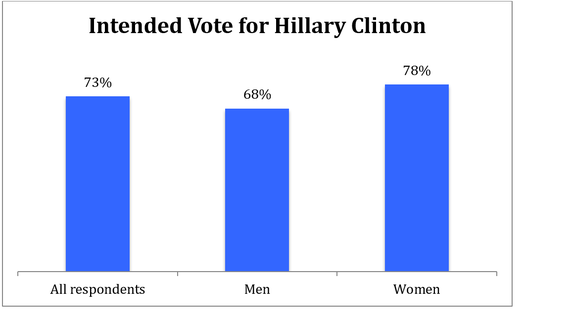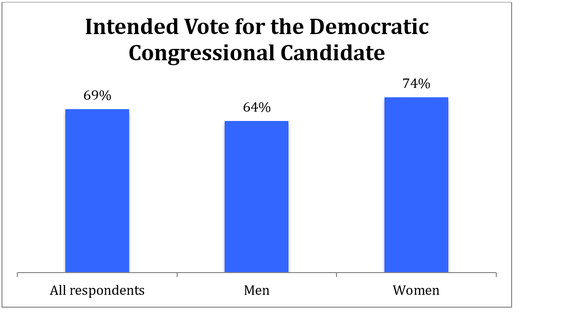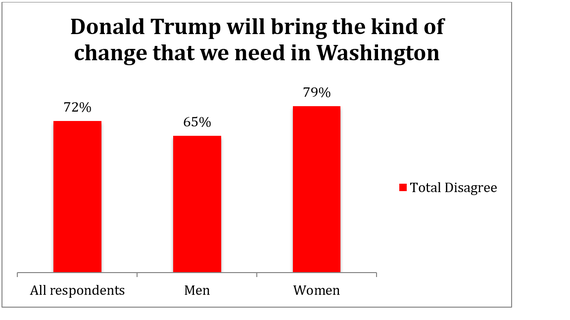Donald Trump’s ongoing derogatory remarks toward women have generated widespread criticism. Not only did he recently say that Hillary Clinton did not have “a presidential look,” but in the first presidential debate Clinton reminded viewers that Trump demeaned Alicia Machado, the Venezuelan Miss Universe, as “Miss Piggy” and “Miss Housekeeping.” These and other degrading remarks have persisted throughout the campaign, tanking Trump’s support among female voters. We may be on the precipice of witnessing one of the largest gender gaps in presidential electoral history.
While political observers have long been interested in differences between men and women in political attitudes and behaviors—the so-called “gender gap”—too often this discussion focuses primarily on differences between white men and white women. Less attention has been paid to analyzing the gender gap among minorities despite the fact that these voters are becoming influential in local and national elections. Latinos are the nation’s largest minority group, and it is paramount that we investigate their political beliefs and behaviors. Latinas (women) may be particularly decisive in upcoming elections since their registration and voter turnout rates are surpassing those of Latinos (men).
This is the third week of the tracking poll of the Latino electorate undertaken byLatino Decisions, National Association of Latino Elected Officials Education Fund and Noticias Telemundo. This week we take a closer look at the data by analyzing the gender gap between Latinas and Latinos. Several key points emerge from these results:
- In general, Donald Trump is doing poorly, and Hillary Clinton is faring well among Latinos;
- Clinton does especially well, and Trump especially poorly with Latinas (in other words there is a Latina/Latino gender gap); and
- Similar differences exist in congressional races.
Let’s examine each of these findings in some details.
One of the most important questions in the tracking poll captures Latinos’ intended vote choice for the presidential race. Respondents are asked if the election were held today would they vote for Donald Trump, Hillary Clinton or someone else?

The table above reports the intended vote choice of persons who are certain and leaning toward Clinton. Nearly three-quarters (73 percent) of all respondents say they are supporting her. However, when we divided the responses by gender, we find that Clinton is more strongly favored by Latinas (78 percent) than Latinos (68 percent) by a gap of 10 points. We have clear evidence of a Latina/Latino gender gap in presidential vote choice for the 2016 election. The tracking poll will allow us to document whether this gap expands or narrows over the course of the election.
While the outcome of the presidential race is capturing much of the media’s attention, there is fear among some Republican members of Congress that Trump’s sexist statements could damage the brand of the GOP among women voters. In the tracking poll, we asked respondents to think about the upcoming congressional elections for the U.S. House of Representatives and whether they intended to vote for the Democratic or Republican candidate.

From the table above, we can observe that 69 percent of Latinos say they will be voting for the Democrat. However, we see that 74 percent of Latinas saying they will vote for the Democrat compared to 64 percent of Latinos who say they will do the same, a gender gap of 10 points. We thus have some evidence that the gender gap is extending to congressional races.
Latina support for Clinton could be driven by a number of factors unrelated to Donald Trump’s campaign. It may be that the presence of Hillary Clinton, the first female presidential candidate that is boosting Latina support for her and the Democratic Party. Further analysis is needed to fully grapple with the “Trump effect.” However, our analysis of Latina/Latino evaluations of Trump reveals some rather stark differences in their appraisal of him. We asked respondents whether they agreed/disagreed with the following statement: “Donald Trump will bring the kind of change we need in Washington.”

What is most obvious from the third table, above, is the 14-point gap between men and women who disagreed with that statement. Clearly, Latinas are reacting more negatively to Donald Trump’s campaign and this is undoubtedly influencing their vote choice in 2016.
This is a historic election for women in a number of ways: A woman is at the top of a major-party ticket, and there is a possibility of one of the largest gender gaps in presidential electoral history. The women’s vote will be decisive. Should Hillary Clinton win, she will owe that victory in large part to Latinas and other women of color.
Rachel VanSickle-Ward, Ph.D., is associate professor of Politics at Pitzer College, and Adrian D. Pantoja, Ph.D., is senior analyst with Latino Decisions and professor of Politics at Pitzer College.

